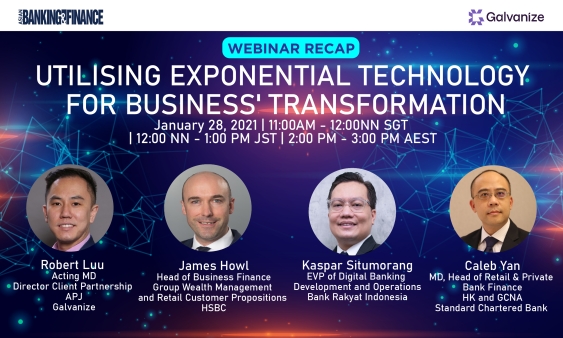
How exponential tech drove Asian banks' business transformation
The webinar discussed trends in digitisation and how banks are effectively using data to enhance processes.
The fast-changing dynamics of digitalisation and customer experience have pushed Asia’s biggest banks to adapt exponential technology to keep up with trends whilst positioning themselves for any future disruption.
During the webinar “Utilizing Exponential Technology for Business Transformation”, which was organized by Galvanize in partnership with Asian Banking & Finance, Asia’s banking leaders discussed the trends involving the digitisation of financial services, and shared how their banks effectively adapted tech in order to expand their services and refine their customer experience.
The key is not just to give users all the data—it’s in effectively using such data, one way of which is to provide customers with insights based on these, according to Caleb Yan, MD, Head of Retail & Private Bank Finance for Hong Kong and GCNA, Standard Chartered Bank.
“One of the areas that the finance function emerging a lot more in these years is in how we provide insights right to business[es],” Yan said during the webinar. “This is not just to give them a lot of data. You need to digest the information in a way that they will know the key areas and trade offs they need to make to enhance their decision-making process and make it more accurate and faster.”
Yan noted that one theme he has observed amongst banks is how they use transactional data from their digital services in order to enhance the decision-making process.
Banks and businesses are delving into what is beyond just understanding the data and driving some insights, asking the questions, what do you do with it, where does it go, and who else needs it, observes Robert Luu, acting MD and director of client partnership APJ at Galvanize.
Actions include taking note how much the organisation requires for regulatory compliance, internal controls for operational efficiencies, and for the organisation’s risk management departments—from operational enterprise risk to even a third-party risks.
“Organisations are starting to embark on collaborating with other digital technologies, outsourcing technologies, and that also imposes new risks, new types of data you can join,” Luu said. “And then of course, people that need to take legacy data legacy system and combine it with the future.”
Luu adds that finance professionals who take note of these options to effectively use data “can make executive and decisive decisions with right accurate data at their fingertips.”
Tech revolution
Proper adoption of technology and leveraging of data has helped the Bank Rakyat Indonesia (Bank BRI), Indonesia’s largest bank and the world’s largest microfinance banking institution, spur business transactions up as well as push its goal of bringing about financial inclusion in the country.
Kaspar Situmorang, executive vice president of digital banking development and operations for Bank BRI, shared that in 2017 the bank noted that its massive banking network was leading to very high operational costs and very high operation risks.
To combat these, the bank combined and structured its massive amount of data from their ledgers and transactions, and used these to provide recommendations on credit scoring, merchant assessments, and customer profiling to the front end of their business. This allowed Bank BRI to accelerate its loan process—from a two-week process, now customers can finish the loan process in as fast as two minutes.
“The impact was immense. The volume of traffic, the volume of financial data, and volumes of transactional data is becoming more massive, especially in the pandemic, [when] our front end transactions increased by 1,000%,” Situmorang said.
However, it’s also important to remember that digital won’t solve everything, notedly from a customer experience perspective, said James Howl, HSBC’s head of business finance, wealth management and retail customer propositions.
Howl noted that whilst digital is a key part of it, banks still need to improve the side of CX.
“Clearly, what we want to get to is that the customer ultimately can choose, [and to make] it as easy as possible to bank with us,” Howl said. “They can choose how they engage with us….if they want to do it on mobile, that should be available. If it comes through the branch or through people, that should also be available.”
“It's working out where digital fits into the broader engagement model, and customer experiences is key,” Howl said.
Remaining nimble
But with the rate the technology is changing, how exactly are banks making the right tech leap and avoid having their investments miss out from being top of range and cutting edge?
Ultimately, it’s all about combining long-term strategy but remaining agile as you move through their digital plans, says HSBC’s Howl.
“From our perspective, we have our long-term strategies, both in finance and on the business side. But we're also very focused on rolling out an agile way of working to enable us to react as we go through that strategy. And yes, of course, I imagine the final endpoint of that strategy in, say, five years' time will be different to what we originally set out, but it will still fit the purpose,” he said.
The key point here is to make sure that they are still meeting and refining their use cases as it evolves to a certain extent as they go through their digital strategy, he added.






















 Advertise
Advertise








